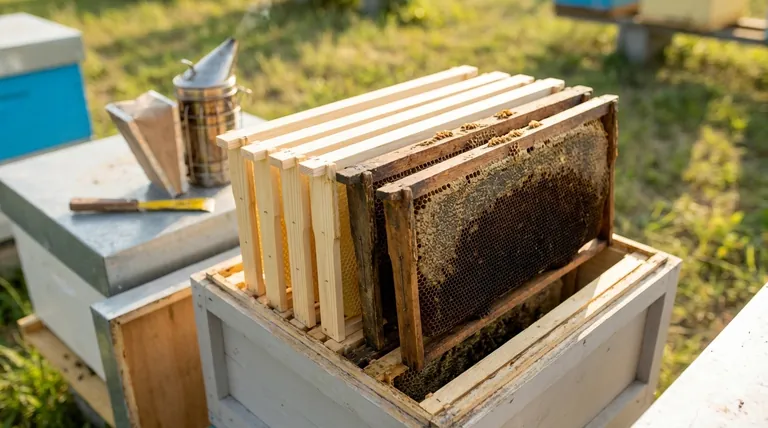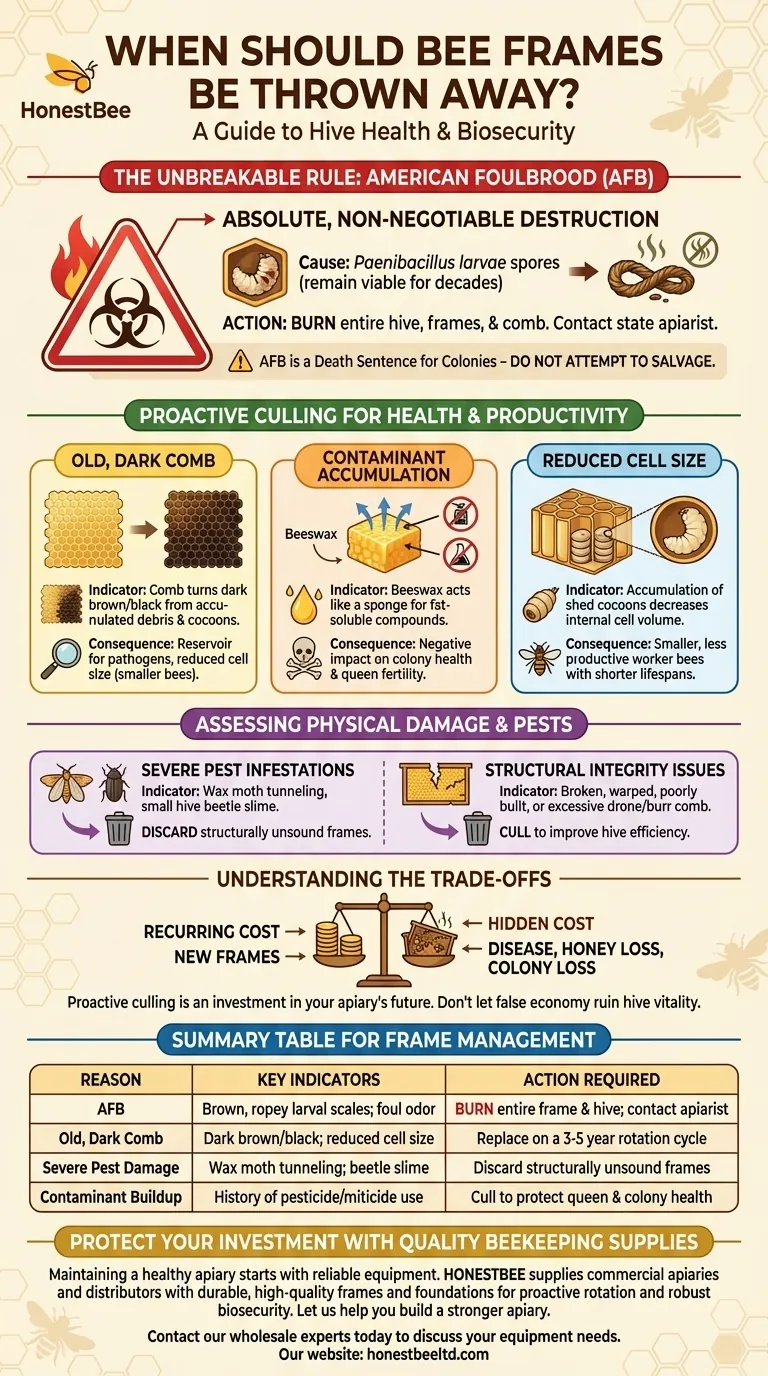In beekeeping, some decisions are absolute. A bee frame that has been exposed to American Foulbrood (AFB) must be discarded and destroyed, typically by burning, without a moment's hesitation. This is a non-negotiable rule of biosecurity to prevent the spread of this devastating bacterial disease.
Your core challenge is not just identifying a hopelessly diseased frame, but establishing a proactive system for frame rotation. Thinking of frames as disposable assets, not permanent fixtures, is a fundamental shift that prioritizes long-term hive health and productivity over short-term savings.

The Unbreakable Rule: American Foulbrood (AFB)
The most critical factor mandating frame destruction is exposure to the spores of Paenibacillus larvae, the bacterium that causes American Foulbrood.
Why AFB is a Death Sentence for Frames
AFB spores are notoriously resilient, capable of remaining viable for decades in old equipment, comb, and honey. The disease infects and kills honey bee larvae, turning them into a brown, ropey scale that dries and hardens on the bottom of the cell.
Once a colony is infected, it is almost impossible to salvage. Attempting to reuse frames from an AFB-infected hive guarantees the disease will reappear, infect new colonies, and potentially spread to other apiaries in your area.
Your Responsibility as a Beekeeper
If you suspect AFB, contact your state apiarist or local bee inspector for a definitive diagnosis. If confirmed, follow their explicit instructions for eradication, which will almost certainly involve burning the entire hive, including all bees, frames, and comb.
Proactive Culling for Hive Health and Productivity
Beyond the absolute rule of AFB, good beekeeping practice involves regularly rotating out old frames to prevent a slow decline in hive vitality.
The Problem with Old, Dark Comb
Over years of use, brood comb Veränderungen from a pale yellow to dark brown or black. This is due to the accumulation of shed cocoons, propolis, pollen, and debris. This old material can become a reservoir for less virulent but still problematic pathogens, such as those causing Chalkbrood.
Contaminant Accumulation
Beeswax acts like a sponge for fat-soluble compounds. Over time, it absorbs environmental pollutants, agricultural pesticides, and even the miticides you use to treat for Varroa mites. This buildup can negatively impact a colony's health and queen fertility.
Reduced Cell Size and Brood Quality
With each generation of brood raised, a cocoon is left behind, slightly reducing the cell's internal volume. Over many cycles, this can lead to smaller worker bees, which may be less productive foragers and have shorter lifespans.
Assessing Physical Damage and Pests
Not all reasons for culling are microscopic. Obvious physical damage is also a clear indicator that a frame needs to be replaced.
Severe Pest Infestations
FramesTunneling by wax moth larvae or heavily slimed by small hive beetle activity should be discarded. While minor damage can sometimes be cleaned up, severely compromised frames are not worth the effort and are structurally unsound.
Structural Integrity Issues
Broken, warped, or poorly built frames that contain excessive drone comb or burr comb should be culled. These frames disrupt the hive's efficiency, promote the production of excess drones, and make inspections more difficult and disruptive.
Understanding the Trade-offs
The decision to discard frames often comes down to balancing cost against risk.
The Cost of Replacement
Frames and foundation are-a recurring expense for any beekeeper. The temptation to reuse old frames to save money is understandable, especially for new or small-scale operators.
The Hidden Cost of Reuse
Failing to rotate out old frames is a form of false economy. The potential cost of a disease outbreak, reduced honey production from a struggling colony, or a complete hive loss palavras dwarfs the cost of new frames. Proactive culling is an investment in your apiary's future.
Making the Right Choice for Your Apiary
A systematic approach to frame management is the most effective strategy. Many experienced beekeepers aim to replace every frame in their brood boxes on a 3- to 5-year cycle.
- If your primary focus is biosecurity and disease prevention: Immediately burn any frame suspected of AFB exposure and aggressively cull any dark, old brood comb annually.
- If your primary focus is maximizing honey production: Regularly replace old, inefficient brood frames to ensure your queen has a clean, productive laying space, leading to stronger colonies.
- If your primary focus is managing a tight budget: Prioritize culling the oldest, darkest, and most damaged frames first, and establish a system to replace at least 2-3 frames per brood box each year.
Treating your frames as a renewable resource is one of the most powerful steps you can take to ensure healthy, productive, and resilient bees.
Summary Table:
| Reason for Discarding | Key Indicators | Action Required |
|---|---|---|
| American Foulbrood (AFB) | Brown, ropey larval scales; foul odor | BURN entire frame & hive; contact state apiarist |
| Old, Dark Comb | Comb is dark brown/black; reduced cell size | Replace on a 3-5 year rotation cycle |
| Severe Pest Damage | Wax moth tunneling; small hive beetle slime | Discard structurally unsound frames |
| Contaminant Buildup | History of pesticide/miticide use | Cull to protect queen fertility & colony health |
Protect Your Investment with Quality Beekeeping Supplies
Maintaining a healthy, productive apiary starts with reliable equipment. Don't let old or compromised frames put your colonies at risk.
HONESTBEE supplies commercial apiaries and beekeeping equipment distributors with the durable, high-quality frames and foundations needed for proactive frame rotation and robust biosecurity. We help you prioritize long-term hive vitality over short-term savings.
Let us help you build a stronger apiary. Contact our wholesale experts today to discuss your equipment needs and ensure your frames are a renewable resource, not a liability.
Visual Guide

Related Products
- Wooden Bee Hive Frames for Beekeeping and Wholesale
- Copper Bee Frame Eyelets for Beekeeping
- Professional Drop-Style Hive Handles for Beekeeping
- Automatic Honey Flow Beehive 4 Frame Mini Hive for Beekeeping
- HONESTBEE Professional Long Handled Hive Tool with Precision Cutting Blade
People Also Ask
- What is the role of oxalic acid in plants? A Key to Plant Defense and Internal Regulation
- What parts of bee equipment should not be painted? Protect Your Hive's Interior for Bee Health
- What are the primary uses of different Langstroth frame sizes? Optimize Your Hive for Health & Honey
- Will honey bees clean up old frames? A Guide to Safe and Efficient Frame Reuse
- What color options are available for plastic frames, and what is the benefit of black frames? Boost Your Hive Inspection Efficiency



















